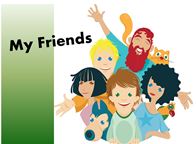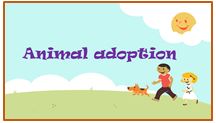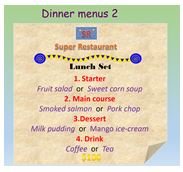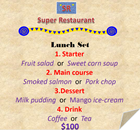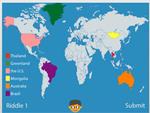| Learning Unit |
Description |
| My Friends |
Learners learn adjectives for people's personality and are taught to describe a person. They also get to know more about “subject and object pronouns” through different class activities. Students will also learn the structures and features of a thank you letter. |
| Animal adoption |
The use of authentic materials and the promotion of e-learning are the highlights of this task. Learners are guided to play online vocabulary games, watch videos and read webpages when learning and applying the vocabulary items, focused sentence structures as well as target reading strategies. Learners are engaged in reading and writing activities to get familiar with the names, body parts and habitats of animals as well as the use of the third person singular verbs and the possessive adjectives in order to prepare them for designing a leaflet on describing animals. |
| Party food 2 |
This package consists of an assessment task, some PowerPoint slides and a reflection form. It is suggested to align teaching objectives with the question intent of the assessment and incorporate the assessment task into the learning and teaching cycle to promote assessment for learning and assessment as learning. The PowerPoint slides are for giving feedback to learners. When providing feedback, learners not only recap strategies they have learned in reading but also apply strategies in a new context. Learners are also guided to reflect on the strategies used by completing the reflection form. Last but not least, learners are encouraged to re-attempt the assessment task or revisit the feedback PowerPoint slides in order to familiarise themselves with the target strategies. |
| Party food 1 |
This package consists of an assessment task, some PowerPoint slides and a reflection form. It is suggested to align teaching objectives with the question intent of the assessment and incorporate the assessment task into the learning and teaching cycle to promote assessment for learning and assessment as learning. The PowerPoint slides are for giving feedback to learners. When providing feedback, learners not only recap strategies they have learned in reading but also apply strategies in a new context. Learners are also guided to reflect on the strategies used by completing the reflection form. Last but not least, learners are encouraged to re-attempt the assessment task or revisit the feedback PowerPoint slides in order to familiarise themselves with the target strategies. |
| Dinner menus 2 |
This package consists of an assessment task, some PowerPoint slides and a reflection form. It is suggested to incorporate the assessment task into the learning and teaching cycle to promote assessment for learning and assessment as learning. The PowerPoint slides contain two main parts, for feedforward and feedback purposes respectively. Teachers may use the feedforward part to draw learners’ attention to the text features of menus while using the feedback part to remind learners of the possible reading strategies to be used. In the part for providing feedback, learners not only recap strategies they have learned in reading but also apply strategies in a new context. Last but not least, learners are encouraged to re-attempt the assessment task or revisit the feedback PowerPoint slides in order to familiarise themselves with the target strategies. |
| Dinner menus 1 |
This package consists of an assessment task, some PowerPoint slides and a reflection form. There is a need to align teaching objectives with the question intent of the assessment. In other words, the assessment task should be incorporated into the learning and teaching cycle to promote assessment for learning and assessment as learning. The PowerPoint slides contain two main parts, for feedforward and feedback purposes respectively. The feedforward part draws learners’ attention to the text features of menus while the feedback part reminds learners of the possible reading strategies to be used. In the part for providing feedback, learners not only recap strategies they have learned in reading but also apply strategies in a new context. Learners are also guided to reflect on the strategies used by completing the reflection form. Last but not least, learners are encouraged to re-attempt the assessment task or revisit the feedback PowerPoint slides in order to familiarise themselves with the target strategies. |
| My family and their jobs |
Scaffolding approach is adopted in this unit. Learners are guided step by step throughout the process in which they learn/recap job names, job nature, workplaces, the language and sentence structure in order to prepare them with the language and organisation for writing about jobs of their family members. |
| Free-time Activities |
By listening to a song, reading a story and being engaged in various activities, learners learn the language and related vocabulary to write about their activities in their free time. |
| Weather and Seasons |
When completing tasks, students read texts about weather in different places as well as learning vocabulary and language items related to weather and places. Finally, they are required to write about four places. |
| Party Food |
Through reading a postcard, a shopping list, promotional flyers, an order form and a conversation, learners practise reading strategies as well as learning vocabulary and language items related to party food in order to write about a party. |
